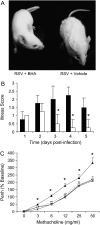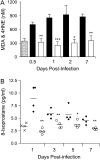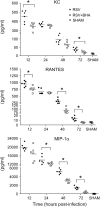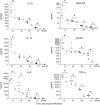Antioxidant treatment ameliorates respiratory syncytial virus-induced disease and lung inflammation
- PMID: 17008643
- PMCID: PMC2648297
- DOI: 10.1164/rccm.200603-319OC
Antioxidant treatment ameliorates respiratory syncytial virus-induced disease and lung inflammation
Abstract
Rationale: Respiratory syncytial virus (RSV) is a major cause of lower respiratory tract infection in children. No treatment has been shown to significantly improve the clinical outcome of patients with this infection. Recent evidence suggests that oxidative stress could play an important role in the pathogenesis of acute and chronic lung inflammatory diseases. We do not known whether RSV induces pulmonary oxidative stress and whether antioxidant treatment can modulate RSV-induced lung disease.
Objectives: To investigate the effect of antioxidant administration on RSV-induced lung inflammation, clinical disease, and airway hyperreactivity (AHR).
Methods: BALB/c mice were infected with 10(7) plaque-forming units of RSV, in the presence or absence of orally administered butylated hydroxyanisole (BHA), an antioxidant. Malondialdehyde and 4-hydroxynonenal were measured in bronchoalveoar lavage (BAL) by colorimetric assay. Cytokines and chemokines were measured in BAL by Bio-Plex and leukotrienes were measured by enzyme-linked immunosorbent assay. AHR to methacholine challenge was measured by whole-body plethysmography.
Results: BHA treatment significantly attenuated RSV-induced lung oxidative stress, as indicated by the decrease of malondialdehyde and 4-hydroxynonenal content in BAL of RSV-infected mice. RSV-induced clinical illness and body weight loss were also reduced by BHA treatment, which inhibited neutrophil recruitment to the lung and significantly reduced pulmonary cytokine and chemokine production after RSV infection. Similarly, antioxidant treatment attenuated RSV-induced AHR.
Conclusion: Modulation of oxidative stress represents a potential novel pharmacologic approach to ameliorate RSV-induced acute lung inflammation and potentially prevent long-term consequences associated with RSV infection, such as bronchial asthma.
Figures









References
-
- Hall CB. Respiratory syncytial virus: a continuing culprit and conundrum. J Pediatr 1999;135:2–7. - PubMed
-
- Glezen WP, Taber LH, Frank AL. Risk of primary infection and reinfection with respiratory syncytial virus. Am J Dis Child 1986;140:543–546. - PubMed
-
- Groothuis JR, Gutierre KM, Lauer BA. Respiratory syncytial virus infection in children with bronchopulmonary dysplasia. Pediatrics 1988;82:199–203. - PubMed
-
- Sigurs N, Bjarnason R, Sigurbergsson F, Kjellman B, Bjorksten B. Asthma and immunoglobulin E antibodies after respiratory syncytial virus bronchiolitis: a prospective cohort study with matched controls. Pediatrics 1995;95:500–505. - PubMed
-
- Garofalo RP, Haeberle H. Epithelial regulation of innate immunity to respiratory syncytial virus. Am J Respir Cell Mol Biol 2000;23:581–585. - PubMed
Publication types
MeSH terms
Substances
Grants and funding
LinkOut - more resources
Full Text Sources
Other Literature Sources
Medical

